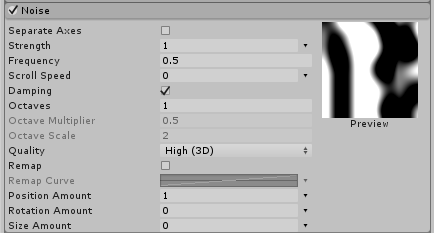Noise module
Add turbulence to particle movement using this module.

Using the Noise module
This module is part of the Particle SystemA component that simulates fluid entities such as liquids, clouds and flames by generating and animating large numbers of small 2D images in the scene. More info
See in Glossary component. When you create a new Particle System GameObjectThe fundamental object in Unity scenes, which can represent characters, props, scenery, cameras, waypoints, and more. A GameObject’s functionality is defined by the Components attached to it. More info
See in Glossary, or add a Particle System component to an exiting GameObject, Unity adds the Noise module to the Particle System. By default, Unity disables this module. To create a new Particle System and enable this module:
- Click GameObject > Effects > Particle System.
- In the InspectorA Unity window that displays information about the currently selected GameObject, asset or project settings, allowing you to inspect and edit the values. More info
See in Glossary, find the Particle System component. - In the Particle System component, find the Noise module fold-out.
- To the left of the fold-out header, enable the checkbox.
API
Since this module is part of the Particle System component, you access it through the ParticleSystem class. For information on how to access it and change values at runtime, see the Noise module API documentation.
Properties
For some properties in this section, you can use different modes to set their value. For information on the modes you can use, see Varying properties over time.
| Property | Function |
|---|---|
| Separate Axes | Control the strength and remapping independently on each axis. |
| Strength | A curve that defines how strong the noise effect is on a particle over its lifetime. Higher values will make particles move faster and further. |
| Frequency | Low values create soft, smooth noise, and high values create rapidly changing noise. This controls how often the particles change their direction of travel, and how abrupt those changes of direction are. |
| Scroll Speed | Move the noise field over time to cause more unpredictable and erratic particle movement. |
| Damping | When enabled, strength is proportional to frequency. Tying these values together means the noise field can be scaled while maintaining the same behaviour, but at a different size. |
| Octaves | Specify how many layers of overlapping noise are combined to produce the final noise values. Using more layers gives richer, more interesting noise, but significantly adds to the performance cost. |
| Octave Multiplier | For each additional noise layer, reduce the strength by this proportion. |
| Octave Scale | For each additional noise layer, adjust the frequency by this multiplier. |
| Quality | Lower quality settings reduce the performance cost significantly, but also affect how interesting the noise looks. Use the lowest quality that gives you the desired behavior for maximum performance. |
| Remap | Remap the final noise values into a different range. |
| Remap Curve | The curve that describes how the final noise values are transformed. For example, you could use this to pick out the lower ranges of the noise field and ignore the higher ranges by creating a curve that starts high and ends at zero. |
| Position Amount | A multiplier to control how much the noise affects particle positions. |
| Rotation Amount | A multiplier to control how much the noise affects particle rotations, in degrees per second. |
| Size Amount | A multiplier to control how much the noise affects particle sizes. |
Details
Adding noise to your particles is a simple and effective way to create interesting patterns and effects. For example, imagine how embers from a fire move around, or how smoke swirls as it moves. Strong, high frequency noise could be used to simulate the fire embers, while soft, low frequency noise would be better suited to modeling a smoke effect.
For maximum control over the noise, you can enable the Separate Axes option. This allows you to control the strength and remapping on each axis independently.
The noise algorithm used is based on a technique called Curl Noise, which internally uses multiple samples of Perlin Noise to create the final noise field.
The settings on the Quality window control how many unique noise samples are generated. When using Medium and Low, less samples of Perlin Noise are used, and those samples are re-used across multiple axes but combined in a way to try and hide the re-use. This means that the noise may look less dynamic and diverse when using lower quality settings. However, there is a significant performance benefit when using lower quality settings.